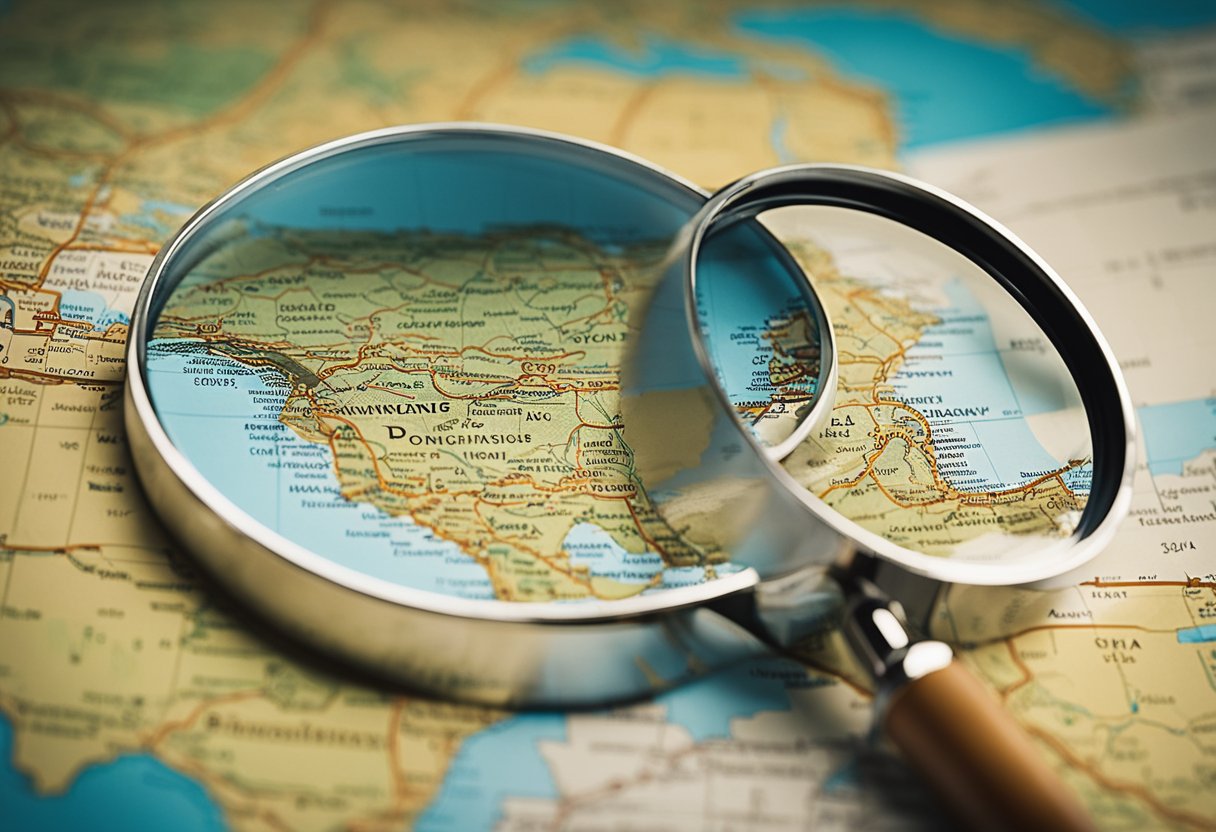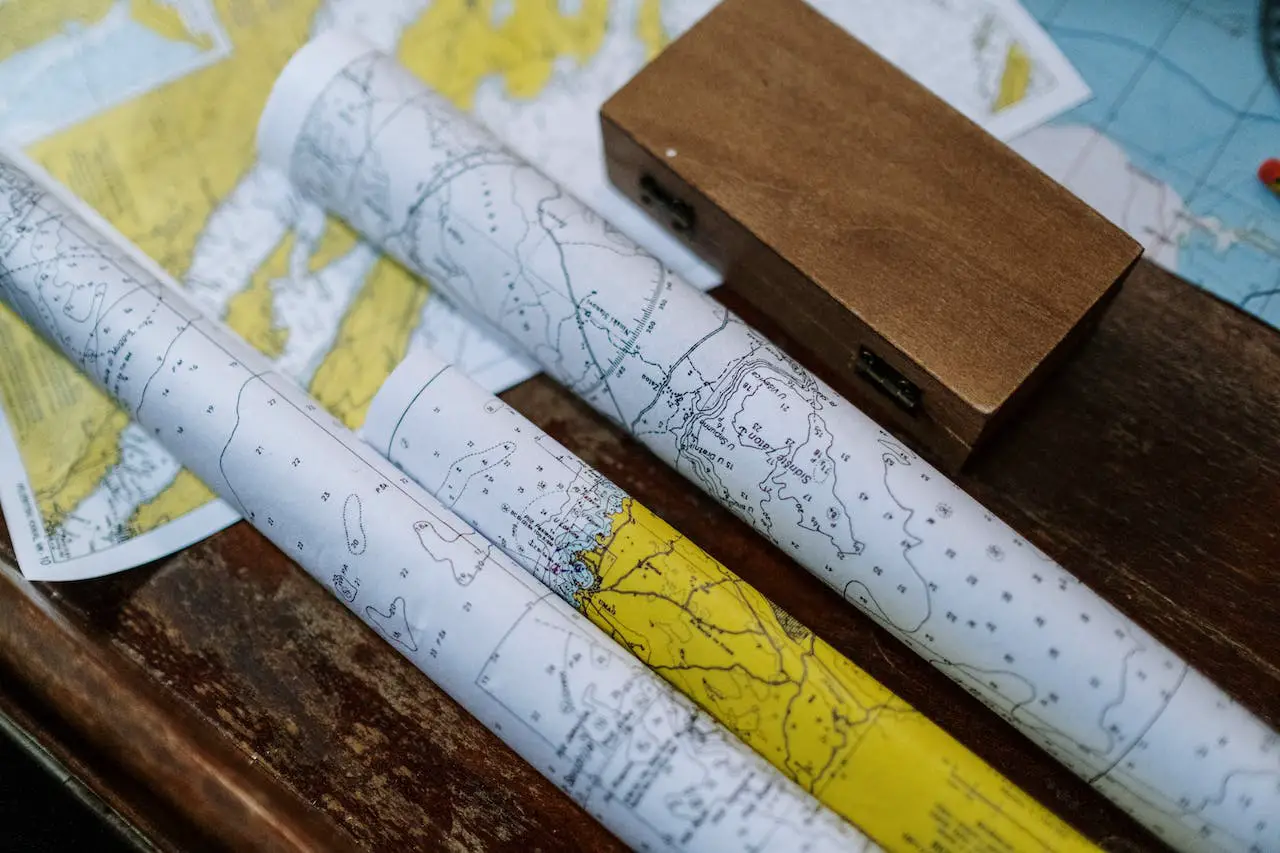“The Map Is Not the Territory” is a critical thinking concept that serves as a metaphor highlighting the differences between our perception of reality and reality itself. Stemming from the field of semantics and popularized by Alfred Korzybski, this adage cautions us not to confuse our mental models and beliefs with the actual world. By understanding the implications of this principle, one can foster better decision-making, communication, and empathy.
In essence, maps are a form of abstraction, simplifying complex information to achieve a better understanding of something. However, it is crucial to remember that these representations are not the same as the objects or territories they represent and may be limited by various factors such as scale or projection. Navigating through life and making informed decisions often rely on the quality and accuracy of the mental maps we use to guide us, which can be influenced by our beliefs, preconceptions, and biases.
Key Takeaways
- “The Map Is Not the Territory” emphasizes the distinction between perception and reality, promoting critical thinking.
- Maps, both literal and metaphorical, are imperfect representations and subject to potential limitations.
- Recognizing the discrepancies between our mental models and reality can enhance decision-making, communication, and empathy.
Understanding the Concept ‘The Map Is Not the Territory’


The concept “The Map is Not the Territory” was introduced by Polish-American scientist and philosopher Alfred Korzybski. He posited that our perception and understanding of reality are not the reality itself, but rather a model, a map of it. This metaphor is used to convey the difference between our subjective interpretation and the actual objective reality.
First, let’s get familiar with the key elements of this concept:
- Korzybski: Alfred Korzybski was a mathematician and philosopher known for his work in semantics. He founded the theory of General Semantics, which deals with the relationship between language and reality.
- Map: In this metaphor, the ‘map’ refers to our understanding or mental model of the world, derived from our experiences, beliefs, and biases.
- Territory: The ‘territory’ represents objective reality, what actually exists, regardless of our perceptions or beliefs about it.
The core idea behind the Map Is Not the Territory is that our mental models are essential in helping us navigate and make sense of the world. However, they are inherently flawed and limited. Hence, it is crucial to distinguish between our models (‘maps’) and the actual reality (‘territory’). This distinction helps us to avoid confusion, prevent misunderstandings, and continually refine our mental models.
Some of the real-life implications of this concept include:
- Interpersonal relationships: Recognizing that your perspective may differ from others’ can help avoid conflicts and facilitate understanding and empathy.
- Decision-making: Being aware of your mental models’ limitations can help you make more informed decisions and remain open to new ideas and information.
In essence, the metaphor “The Map Is Not the Territory” serves as a reminder to constantly evaluate our mental models and stay open to new information. By acknowledging the gap between our understanding and reality, we can become more effective thinkers and communicators, navigating the complexities of the world with greater clarity and confidence.
Origins and Evolution of the Concept


The concept of “The Map Is Not the Territory” can be traced back to Alfred Korzybski, a Polish-American engineer and philosopher. This idea was introduced in his 1931 lecture at an American Mathematical Society meeting. The concept is a foundational principle of general semantics and neuro-linguistic programming.
Korzybski’s original statement emphasizes the notion that our perception of reality is not reality itself, but a representation of it. In other words, we inevitably interact with the world through the lens of our own understanding, which is shaped by our mental “maps”—comprising our beliefs, experiences, and biases. Because our mental maps are constructed and subjective, they will differ from one person to another, and as such, the meaning we ascribe to the “territory” of reality is prone to interpretation.
The “The Map Is Not the Territory” notion has evolved over time, finding its way into various fields of study, including psychology and social sciences. It has been applied to many theoretical frameworks, and it can assist in understanding the importance of challenging our preconceived notions and biases to maintain an objective perspective.
In summary, “The Map is Not the Territory” is a powerful concept that originated from Alfred Korzybski’s lecture on the importance of acknowledging the gap between our perception of reality and the actual world. Since its introduction, this concept has become a cornerstone in the fields of general semantics and neuro-linguistic programming, proving its relevance and adaptability to various disciplines and theoretical frameworks.
Understanding Maps as Representation


The concept of “The Map Is Not the Territory” highlights the important distinction between an object or phenomenon and its representation. In essence, a map serves as an abstract representation of a given territory. It simplifies complex landscapes by providing a scaled-down, comprehensible depiction of the area.
However, it is crucial to remember that maps are not exact, one-to-one replicas of the territories they represent. Instead, they are abstract interpretations that convey specific features or characteristics of a region. Consequently, maps might omit details or showcase them differently, depending on the purpose they serve and the mapmaker’s vision.
For instance, a physical map emphasizes the natural features of a territory, such as mountains, lakes, and rivers, while a political map showcases borders, cities, and administrative divisions. Furthermore, maps can be subjective, reflecting the biases or preferences of their creators. To better understand maps as representations, consider these key points:
- Maps are simplifications: Due to their inherently abstract nature, maps condense and simplify complex information. They cannot capture every detail of a territory; instead, they prioritize specific features or purposes.
- Accuracy is relative: An accurate map may be precise in some aspects but not in others. For instance, a map whose primary focus is on political divisions may disregard geographical information.
- Different maps, different perspectives: Various maps offer unique perspectives and interpretations of a territory. A single region can be portrayed differently in physical, political, or thematic maps.
To fully grasp the concept of the map not being the territory, it is essential to think critically and evaluate the validity and limitations of any given representation. Treat maps as imperfect interpretations of reality, and recognize that each map serves its specific purpose while lacking a comprehensive account of the territory.
Perception and Reality


The concept of “The Map Is Not the Territory” highlights the distinction between reality and an individual’s perception of reality. It emphasizes that a person’s understanding of the world is merely a representation of reality and not reality itself 1.
In order to better grasp this distinction, consider the following key elements:
- Objective Reality: This refers to the actual world outside of an individual’s perspective, independent of thoughts and beliefs. Objective reality exists regardless of anyone’s awareness or comprehension of it.
- Perception: Perception encompasses the way an individual interprets and understands the objective reality through their senses and cognitive processes. Each person’s perception is shaped by unique experiences, beliefs, emotions, and cultural background.
- Perception of Reality: This term combines the concepts of perception and objective reality, describing the mental model individuals create based on their subjective interpretation of the world 2.
The metaphor of map and territory effectively illustrates the difference between the actual world (the territory) and our understanding of it (the map) 3. The map is a mental representation of the territory, and it’s crucial to remember that the map isn’t the same as the territory itself.
To easily comprehend these distinctions, let’s discuss a brief example:
Suppose you’re planning a trip to a foreign country. The map you use to navigate is only an approximation of the actual territory. The map may contain inaccuracies, outdated information, or fail to capture the nuances of the terrain. Your map represents your perception of reality, while the actual geographic landscape is the objective reality.
By recognizing the inherent limitations of our perceptions, we can develop a more accurate understanding of the world, minimize cognitive biases, and improve our decision-making processes 4.
In summary, “The Map Is Not the Territory” serves as a crucial reminder that the objective reality is distinct from our individual perceptions. Acknowledging this fundamental idea empowers us to question and refine our mental representations to better align with the truth.
Role of Beliefs and Preconceptions


When discussing the idea of “The Map Is Not the Territory,” it is crucial to consider the role that our beliefs and preconceptions play in shaping our understanding of reality. These mental constructs can significantly impact our perception and decision-making process.
Our beliefs are formed based on the convictions we hold about the world. Beliefs are often influenced by our upbringing, cultural background, and experiences. Preconceptions, on the other hand, refer to the assumptions we make before encountering the actual facts or experiences. Both beliefs and preconceptions can influence our cognitive processes, including how we perceive, interpret, and react to the world around us.
An essential factor that plays a crucial role in shaping beliefs and preconceptions is our cognitive biases. Cognitive biases are systematic errors in the way we think, leading to distorted perceptions or illogical conclusions. For example, confirmation bias occurs when individuals seek out and favor information that supports their pre-existing beliefs while ignoring or discounting contradicting evidence. Other common cognitive biases include the availability heuristic, the anchoring effect, and the bandwagon effect.
These biases might result in distorted mental models—our internal representations of the world. Mental models are simplified versions of reality, often influenced by our experiences, beliefs, and preconceptions. For instance, if one has a negative experience with a specific group of people, they might unconsciously create a mental model that portrays the entire group negatively, leading to prejudice and discrimination.
Considering the interconnectedness of beliefs, preconceptions, cognitive biases, and mental models, it becomes increasingly important to be aware of these factors and their potential effects on our understanding of reality. By examining and challenging our beliefs and preconceptions, we can reduce the influence of cognitive biases and develop a more accurate and nuanced understanding of the world. This ability to adapt our mental models to better represent reality is crucial for successful navigation and decision-making in an ever-changing environment.
Exploring Limitations of Maps


Maps serve as abstractions and representations of real-world territories, providing useful means for navigation and understanding geographical locations. However, they come with certain limitations that can lead to misconceptions, misunderstandings, or even misinterpretations of the territory they represent.
One key challenge of map-making is the inherent distortion that arises from representing a three-dimensional terrestrial surface on a two-dimensional plane. This distortion can affect areas, distances, and angles between places, potentially leading to misunderstandings. For instance, the Mercator projection, a commonly used map type, may exaggerate landmasses at high latitudes, making them appear much more extensive than they are in reality.
Another limitation is the selectivity of information shown on maps. Cartographers must choose which elements to include or exclude, as it is impossible to represent every detail of a territory on a small scale. Consequently, some maps might prioritize political boundaries, while others focus on topography and landmark features. Users should be aware of a map’s intended purpose and treat its information critically to avoid misinterpretations.
Furthermore, maps might inadvertently perpetuate inaccuracies or biases, resulting from historical events or political agendas. For instance, disputed borders may be depicted differently on maps produced in different countries. It is essential for users to recognize these potential biases and consider multiple map sources to gain a more comprehensive perspective.
Lastly, maps become outdated as the territory they represent evolves. As landscapes, political boundaries, and infrastructures change over time, maps must be continually updated to maintain accuracy. It is crucial to verify the source and date of a map to ensure it still presents relevant and accurate information about the territory.
To sum up, the popular saying, “The map is not the territory,” serves as a reminder of the limitations inherent in maps as abstractions of real-world territories. Users should approach maps with a critical mindset, recognizing that information may be distorted, selective, biased, or outdated. Ultimately, understanding the confines and characteristics of maps will promote better-informed decision-making and a clearer comprehension of the world around us.
Importance of Abstraction


Abstraction plays a vital role in understanding complex concepts and simplifying information for easier comprehension. One such prominent example is the concept of The Map Is Not the Territory, which highlights the significance of abstraction in our perception of reality.
In essence, the metaphor “The Map Is Not the Territory” addresses the fact that our mental representations or models of reality are inherently limited. Just as a map offers a scaled-down version of a specific area, our mental models are abstractions that allow us to navigate and comprehend the world. However, they do not encompass the entirety of the actual territory or reality.
Abstractions enable us to break down complex ideas, situations, or systems into simpler components to make sense of them. When creating models or maps, we often emphasize certain aspects and exclude others, which might lead to an incomplete or even distorted understanding of the actual territory. Some common types of abstractions include:
- Generalizations: Grouping similar objects, situations, or concepts under a broader category to reduce complexity.
- Simplifications: Streamlining complex information or systems by focusing on key elements and discarding less crucial details.
- Analogies: Comparing unfamiliar concepts or situations with familiar ones to establish a better understanding.
It is crucial to recognize the differences between the represented abstractions and the underlying reality. By acknowledging the limitations of our mental models and abstractions, we can prevent overreliance on them and continuously strive to refine our understanding of the world.
Theory and Context in Maps


The concept of “The Map Is Not the Territory” was developed by mathematician and philosopher Alfred Korzybski. He aimed to illustrate the difference between the actual world and our understanding of it as we perceive it. This metaphor implies that a map (our understanding) may not always accurately represent the territory (reality).
At its core, this idea emphasizes that models and theoretical frameworks are simplified representations of complex contexts. Therefore, it is crucial to maintain a critical mindset when using these tools to navigate the world. For instance, political, geographical, or economic maps might not convey cultural, historical, or social nuances accurately. A map can capture or omit specific details, leaving the viewer with an incomplete understanding.
When developing or using a theory, one should keep in mind that its utility depends on how accurately it reflects the context. The significance and relevance of a theory can vary based on the observer and the contextual factors that impact their interpretation of these maps. For example, a sociopolitical model may become less useful when applied to a very different cultural or historical context. In essence, maps, theories and models serve as guides, but they are by no means comprehensive representations of reality.
To utilize maps and theories effectively, it is essential to recognize their limitations and adopt an open, adaptable approach. Embracing a flexible and agile perspective allows for a more nuanced understanding of the complex, ever-changing territories we encounter. This mindset can lead to better problem-solving, decision-making, and overall critical thinking.
In summary, the Map Is Not the Territory principle serves as a reminder to maintain a discerning approach when utilizing models, theories, or maps. It highlights the necessity of considering various perspectives and the limitations inherent in any representation. Both in academic and everyday life, it is crucial for individuals to remain attentive to the distinction between their perceptions and reality.
Application in Decision-Making


The concept of “The Map Is Not the Territory” plays a crucial role in decision-making and problem-solving. By acknowledging that our perception of reality is not the same as reality itself, we can make better decisions. Let’s explore the ways this principle can be applied to decision-making.
First, we must accept that our mental models or maps are a representation of reality, which implies that they come with limitations. Our biases, beliefs, and experiences can all shape our perceptions. By being aware of these limitations, we can strive to maintain a neutral and clear viewpoint, questioning our assumptions and seeking alternative perspectives to broaden our mental map.
One way to enhance our decision-making process is by incorporating a variety of mental models. By using multiple models, we can better understand complex situations. Below are a few models that complement the concept of “The Map Is Not the Territory”:
- Circle of Competence: It encourages us to focus on areas where we have significant expertise.
- First Principles: A method of breaking down a problem into fundamental elements to gain a deeper understanding.
- Second-Order Thinking: Consideration of the consequences of our decisions beyond their immediate impact.
Another practical application of this concept in decision-making is embracing feedback. When we receive feedback, our instinctive reaction might be to dismiss, deny or even get defensive. But, if we remember that our mental map may be incomplete or distorted, we can use feedback as an opportunity to refine our understanding.
Additionally, we should be cautious of overconfidence in using our mental maps, as it may lead to cognitive biases or inaccurate conclusions. Aiming for intellectual humility allows us to recognize our own cognitive limits and fosters a collaborative approach in decision-making.
In summary, “The Map Is Not the Territory” serves as a powerful reminder during decision-making and problem-solving. By being aware of our mental map’s limitations and incorporating multiple models, refining our understanding through feedback, and embracing intellectual humility, we can make better decisions and navigate the complex territories of reality.
Application in Communication


The concept of “The Map Is Not the Territory” plays a significant role in understanding and improving communication. This metaphor, originated by Alfred Korzybski, highlights that an individual’s perception of reality is not the same as reality itself, but rather a representation of it. In other words, our mental ‘maps’—composed of our beliefs, experiences, and personal interpretations—do not always align with the actual ‘territory’ or objective reality. This distinction is crucial in the realm of communication.
When it comes to language, it is essential to remember that words and phrases are merely symbols representing our thoughts and ideas. These expressions may not always capture the full essence or meaning of the experiences they aim to describe. Different people have their unique mental maps, which influence how they perceive and interpret the world around them. Consequently, it is important in effective communication to acknowledge and adapt to these differences in order to reduce ambiguity, misunderstanding, and potential conflicts.
One way to apply the “Map Is Not the Territory” concept is to employ certain techniques in communication to ensure better clarity between individuals. For example:
- Active Listening: Paying close attention to what the speaker is saying, asking clarifying questions, and summarizing the message can facilitate a shared understanding between the participants.
- Emphasis on Context: Providing relevant context when presenting ideas or opinions can help others better comprehend the intended meaning, thus preventing misinterpretations.
- Use of Analogies and Metaphors: Utilizing familiar analogies or metaphors can bridge the gap between different mental maps and assist in conveying complex ideas more effectively.
- Avoiding Assumptions: Presuming that others share the same mental maps can hinder effective communication. It is crucial to be aware of our assumptions and verify their accuracy with the involved parties.
The “Map Is Not the Territory” principle in communication emphasizes that it’s important to distinguish between our personal perceptions and objective reality. By keeping this metaphor in mind and utilizing various techniques to adapt our communication, we can foster better understanding and more effective communication between individuals with differing perspectives and mental maps.
Understanding Biases and Empathy


In the realm of critical thinking, biases and empathy play important roles in influencing our perceptions and understanding of reality. When examining the concept of “The Map Is Not the Territory,” it is essential to consider the impact of cognitive biases and the importance of empathy in decision-making.
Cognitive biases are systematic errors in thinking that affect our judgment and decision-making processes. Some common cognitive biases include confirmation bias, anchoring bias, and availability bias. For instance, confirmation bias leads us to favor information that confirms our preexisting beliefs or values. This tendency can significantly distort our mental maps and prevent us from accurately assessing the territory of reality.
To combat these biases and improve our critical thinking, it is essential to practice mindfulness. Mindfulness involves becoming aware of our thoughts, emotions, and actions without judgment, allowing us to recognize and address any potential biases. By cultivating mindfulness, we can reduce the impact of cognitive biases on our perceptions and decision-making processes.
In addition to understanding biases, empathy is another key component in successfully navigating the complex landscape between our mental maps and reality. Empathy allows us to step into another person’s shoes and imagine their thoughts, feelings, and perspectives. Through empathy, we can more accurately perceive the territory by considering multiple perspectives, enhancing our mental maps.
Incorporating empathy into our thinking and decision-making processes also strengthens our relationships by fostering understanding and compassion. It is a vital skill that helps diminish conflicts and promotes collaborative problem-solving, leading to more accurate and beneficial outcomes for all parties involved.
In conclusion, recognizing and addressing our cognitive biases, while cultivating empathy, are essential steps toward enhancing our critical thinking abilities. As we keep in mind that “The Map Is Not the Territory,” we can strive to create more accurate mental maps by overcoming biases and embracing empathy, leading to better personal and professional decisions.
Conclusion


The concept of The Map Is Not the Territory serves as a valuable reminder for critical thinkers that our perception of reality and the actual reality might not always align. Systematic biases, errors, and personal experiences can lead to distorted maps of reality. Embracing this notion can enhance decision-making and thinking processes.
One can practice this critical thinking concept by acknowledging that human perception is inherently subjective, thus it is crucial to question our assumptions and beliefs regularly. Furthermore, understanding that maps are ultimately simplified versions of reality can help in sharpening our analytical skills.
To utilize the full potential of this concept, consider the following recommendations:
- Be curious and open to new information that contradicts your existing beliefs or understanding.
- Engage in active learning and pursue diverse perspectives to reduce the gaps in your mental maps.
- Develop a healthy skepticism when consuming information or data, and question the source’s reliability.
In summary, embracing “The Map Is Not the Territory” can lead to better evaluation of information, improved decision-making, and heightened awareness of cognitive biases. Integrating this concept into daily life can help individuals navigate the complexities of the world with greater clarity and confidence.
Frequently Asked Questions
What are the key principles behind the map is not the territory concept?
The map is not the territory concept emphasizes that our understanding of reality (the map) is not the same as reality itself (the territory). It highlights how our perceptions, beliefs, and mental models can deviate from the actual state of the world. This notion serves as a reminder to question our assumptions and avoid confusing our subjective interpretations with objective reality.
How does understanding the map-territory distinction improve critical thinking?
Grasping the map-territory distinction helps improve critical thinking by fostering self-awareness and humility, which in turn, encourages individuals to examine their biases, question their perspectives, and seek alternative viewpoints. By understanding that our mental maps are not the actual territory, we become more open to refining our beliefs and adapting our decisions based on new or contradicting information.
What are the common pitfalls associated with confusing the map with the territory?
Confusing the map with the territory can lead to various pitfalls, such as cognitive biases, rigid thinking, and poor decision-making. For instance, over-reliance on a familiar mental model may result in confirmation bias, where one tends to favor information that supports their existing beliefs while dismissing contradictory evidence. Moreover, the inability to differentiate between the map and the territory can lead to miscommunication and misunderstandings in our personal and professional lives.
How can the map is not the territory concept be applied to decision making?
Applying the map-territory concept to decision making involves recognizing the limitations of our mental maps and being open to reevaluating them when new information emerges. We should also seek diverse opinions and perspectives to enhance our understanding of the situation and make informed decisions. Embracing this concept can help minimize biases, promote cognitive flexibility, and ultimately lead to better decision-making.
What role do mental models play in the map-territory distinction?
Mental models are simplified representations of complex systems or concepts, which help us make sense of the world. In the context of the map-territory distinction, mental models contribute to the creation of our mental maps. While these models serve as useful tools for understanding and predicting situations, it is essential to recognize their limitations and be willing to adjust them as new information becomes available.
Who first introduced the concept of the map not being the territory?
The concept of the map not being the territory was first introduced by Polish-American scientist and philosopher Alfred Korzybski. He developed this idea to emphasize how our understanding of the world (the map) is inherently limited and can never fully capture the complexity of reality (the territory). This concept serves as a cornerstone for various disciplines, including linguistics, psychology, and general semantics.





